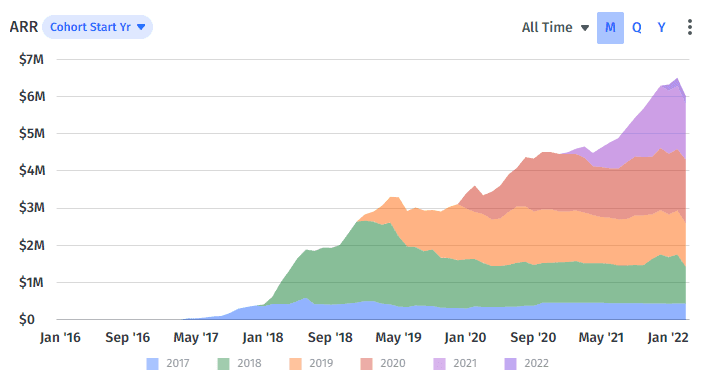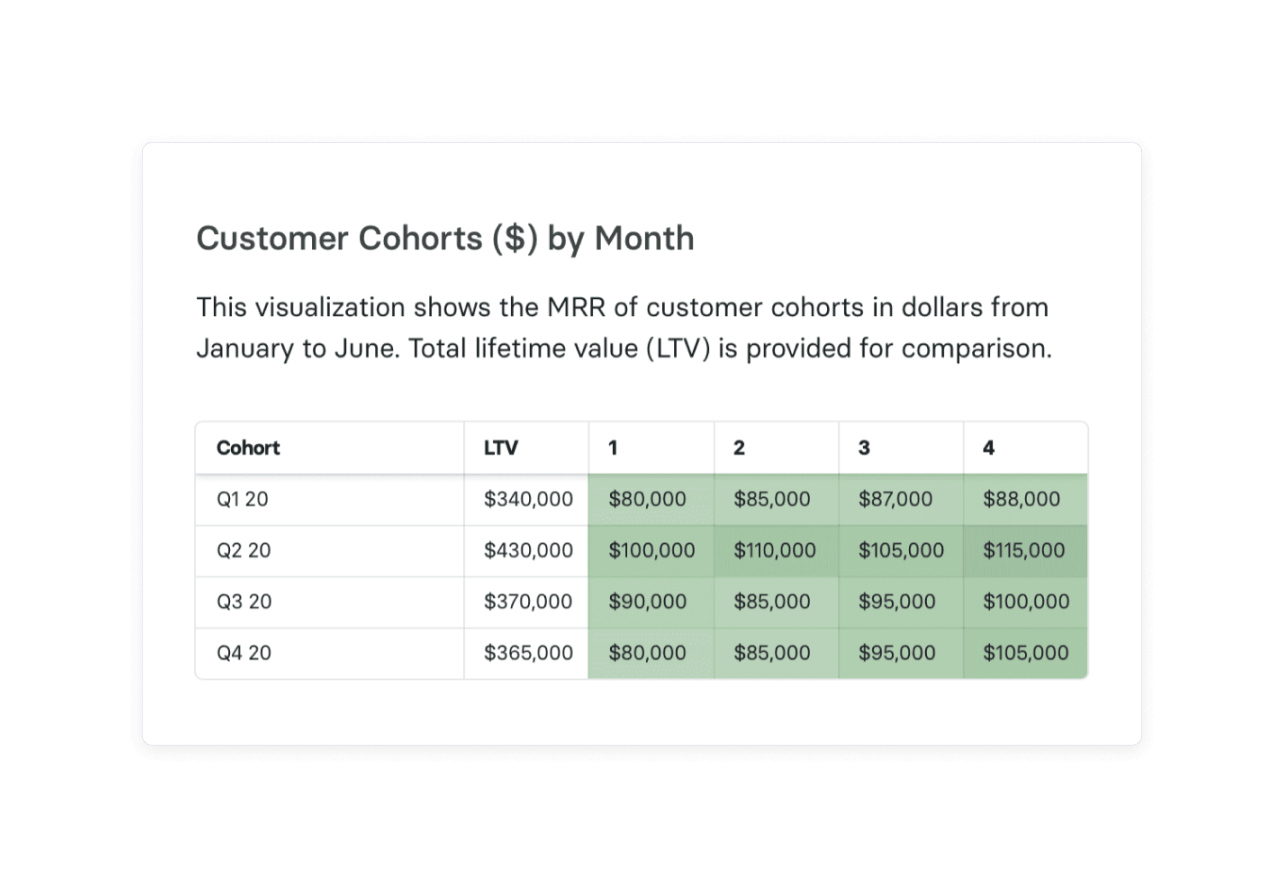As a SaaS business, your goal isn’t just to gain as many customers as possible — it’s to retain them, prevent churn and, ideally, increase customer value over time. This responsibility lies with customer success teams. But with a large portfolio of customers, it’s not always obvious where customer success teams should focus their efforts.
This is where a strong customer health score comes into the picture — well-built customer health scores act as a guide for which customers are ready for renewals and upsells while also giving insight into which customers may unfortunately churn. But how “well-built” that score is depends on which metrics you choose and how strong of an indicator they are of churn.
Traditionally, customer health scores rely on indicators like product usage and net promoter score. While these remain important, a modern approach means contextualizing them with financial metrics that reflect the unique nature of your company.
Table of Contents
What Is a Customer Health Score?
A customer health score is a custom measurement that shows companies how likely a specific customer or group of customers is to churn, renew, or buy more products. For SaaS businesses, it’s a snapshot based on metrics like usage time, feedback, or interaction with support.
The goal of a customer health score is to provide customer success teams with a quick, easy-to-understand assessment of which accounts they need to focus on to reduce churn and streamline capital efficiency. It also helps identify healthy customers who may be prime targets for renewals and upsells.
The challenge is that there isn’t one standard formula for calculating your customer health score. Factors predictive of customer churn for one business may not apply to another business, even within the same industry. And factors that indicate the likelihood of renewal for one customer segment may not apply to another cohort of customers within the same business. So, companies need to tailor their customer health scoring to their unique business and customers.
How To Create a Customer Health Score in 4 Steps
Customer health scores are meant to provide customer success managers with a quick, easy-to-understand view of how at risk of churn a customer is. That’s why they’re typically divided into numerical, color-coded, or grade-based (A to F) scales.
Which option should you go with? We suggest using a numerical scoring system, mainly because this helps ensure an accurate reflection of the weight of each factor in a customer’s likelihood to churn (more on that below).
So, your final customer health score will be a number between 1 and 100, with higher scores indicating better health.
1. Select Customer Health Score Metrics
The first step to building your customer health score is identifying which factors you want to measure. Some factors commonly reflected in customer health scores include:
- Customer feedback
- Usage time
- Number of features being used (usage depth)
- Number of support tickets
- Request for new features
- Account age
- Net promoter score and CSAT
- Customer engagement
- Relationship sentiment
2. Outline Positive and Negative Indicators for Each Metric
Once you’ve selected which customer success metrics are relevant to your company and unique customer base, you’ll need to divide those metrics into positives and negatives. For instance, a high net promoter score would be positive because it indicates less likelihood of the customer churning. Low usage time would be negative since it probably indicates a higher likelihood of churn.
When calculating your numerical score, add positive indicators and subtract negative ones. For example, high usage time of a variety of product features might add 20 points to your score, while a customer opening 4 support tickets over 2 weeks might subtract 5 points.
3. Assign Weights
But not all of the customer data you leverage has the same weight. Sure, 4 support tickets opened over a couple of weeks might look bad, but a customer not using the product at all for a month is arguably a higher indicator of churn.
That’s why you’ll need to assign weight to each customer health score metric — different numerical values based on how great of a risk they indicate.
One of the best ways to assign weight to components of your customer health score is by looking at historical data. What actions did former customers take before they churned? If there was a reduction in usage depth, you’d know to add more weight to that factor.
On the other hand, you can set benchmarks for specific factors. For example, how often are your best customers using the product? What about those who churn?
When building a customer health score you should identify the highest value features of your product and ensure they are being used. If they are, it’s a good sign a customer is getting the value they signed up for. If they aren’t, use that signal early and often to try to push adoption.
4. Segment
Working in SaaS, you know not all customers are the same. A good customer health score formula reflects this by segmenting customers for company size and industry, as well as what stage they’re at in the customer journey. And, to make your weights even more accurate, you can assign different weights for different factors in different segments.

For instance, the number of advanced features being used might carry more weight in larger companies, where they need access to tools like role-based access controls. In smaller companies, however, usage of these features may not be as important, while high usage time is.
The Significance of Customer Health Score for Finance Teams
Traditionally, customer health scores have mostly been relevant to customer success teams. By showing how likely a customer is to churn, a customer health score helps success teams direct their efforts. But there’s an overlooked use for finance here, too: building more accurate top-line forecasts.
Customer health scores reflect the likelihood of a specific account churning or renewing. They also help identify prime targets for upselling. Accurate top-line forecasts depend on properly forecasting churn, renewals, and upsells. This makes customer health scores a cheat sheet not just for customer success, but for finance, too.
Improves Accuracy of Financial Models
Creating an accurate top-line forecast is foundational to a robust financial model. It’s the first step in budgeting and creating realistic growth targets and helps build trust with investors.
Since customer health scores reflect the likelihood of churn, renewals, and upsells, they can help you build your revenue forecasts.
SaaS Financial Model Template
A great example of how this works is the ARR snowball model. The ARR snowball model is a top-down approach to revenue forecasting that forecasts new customers, churn, upgrades, and downgrades.
Taking the snowball model one step further, you can enrich your renewal and churn forecasting with customer health score data.
Forecasting these depends typically on a combination of historical data and assumptions. Customer health score can function like a litmus test when assessing your assumptions about churn, upgrades, and downgrades across specific customer segments.
For instance, once customer success has built these scores, finance can look at historical and real-time data to find the number that indicates a customer is most likely to churn. Using a weighted average, finance can then apply that to renewal bookings across specific customer segments, with specific percentages based on likelihood of renewal.
As an example, your grouping might look something like this:
| Customer Health Score | Chance of Renewal |
|---|---|
| 90 - 100 | 100% |
| 60 - 70 | 75% |
| 20 - 40 | 25% |
And so on.
You can then do the same for likelihood of upgrade or downgrade.
In this way, a well-constructed CHS is another tool finance can use to build tighter top-line forecasts that inform a sustainable company strategy.
Adds Context to Metrics
Customer retention metrics like net revenue retention, logo retention rate, and MRR churn are some of finance’s most important for maximizing customer lifetime value.
When you segment customers by their customer health scores, you can get more granular insight into the relationship between churn and specific financial metrics.
For example, is there a specific pattern in net revenue retention rate? Maybe it drops off quite suddenly before a customer churns. Maybe customer health scores are higher in certain segments like company size or industry and lower in others. Finance can use their analytical skill set to share this information with customer success teams, sales and leadership teams to help focus on opportunities and fix gaps.
Building a Collaborative Approach Between Finance and Customer Success
Customer health score is an excellent place for finance and customer success to meet because it touches on factors they’re both concerned with: churn and customer value over time.
If you think about it, metrics like logo retention rate and customer health score are really two sides of the same coin.
If you have a decreasing logo retention rate, for instance, customer health score can help explain why. Through integration with your systems, customer success teams can connect logo retention rate to other factors — qualitative metrics like NPS or time spent using specific features. They can then assign those a much higher value when building customer health scores.
There should be close collaboration between the CFO and the head of customer success. Picture regular meetings where both department leaders discuss accounts that are in the red, and identify the tell-tale signs of customer attrition. CFOs can then build that knowledge into their financial forecasts, while customer success managers build it into their customer health scores.
Customer Health Score: Bringing It All Together With Mosaic
Collaboration between finance and customer success requires a centralized view — integration of relevant systems like CRM, customer success software, and ERP.
With Mosaic, you can connect all three, viewing customer health scores in your CFO dashboard alongside more typical financial efficiency metrics like CAC:LTV or SaaS magic number. Using weighted averages, finance can then determine the likelihood of renewal partially based on customer health score, creating more accurate revenue forecasts that serve as a stronger guide to company policy.
Finance leaders can also cross-reference specific customer segments by score with financial metrics like net revenue retention or logo retention, and share this information with the customer success team. This helps them construct scoring systems expertly tailored to your business.
In Mosaic, everyone can refer to the same data and “speak the same language” across departments. A consolidated approach has the ultimate effect of boosting retention, saving on spend, and generating more cash for the business.
Want to see how Mosaic can support collaboration between your finance and customer success teams? Request a personalized demo today.
Customer Health Score FAQs
Why should businesses monitor their customer health score?
Customer health score shows which accounts are most likely to churn and which are prime targets for upselling. In this way, it helps direct a customer success team’s efforts.
Customer health scores can also be useful to finance teams, who can leverage these scores to build more accurate churn and renewal forecasts.
How can you improve customer health scores?
Own the of your business.


